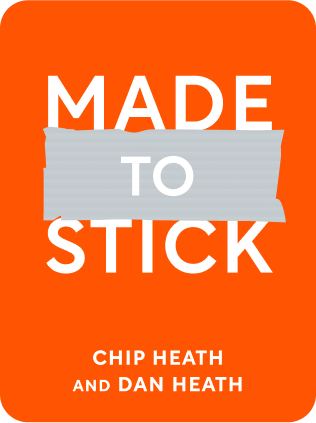

This article is an excerpt from the Shortform book guide to "Made to Stick" by Chip Heath and Dan Heath. Shortform has the world's best summaries and analyses of books you should be reading.
Like this article? Sign up for a free trial here .
Do you have an idea in mind? What is the core message behind your idea?
If you have an idea to communicate, you want it to be sticky: you want people to understand it, remember it, and pass it on. The key to doing this is twofold: identifying your core message and making it compelling.
Here is how you can distill the core message of your idea and make it stick.
Sticky Ideas Are Simple
In the simplest terms, there are only two steps to making your idea stick: 1) find the core message and 2) make the core message compelling by using the SUCCESs template.
The first sentence above is an example of what you need to do with your message. It distills the essence or core of this book to a single sentence, albeit not a scintillating one.
Find the Core Message
The “S” in the SUCCESs formula for creating “sticky” messages stands for “simple.” Making your message simple doesn’t mean dumbing it down or making it simplistic like a typical sound bite. Simplifying it just means determining the most important thing about it, the essence or core that holds it together like gravity.
It must focus on one thing, not multiple things. The challenging part is prioritizing your points and then eliminating all but one central point. A simple, well-designed idea effectively shapes and guides others’ behavior. The following are some examples of how core-focused messages are created and how they work.
Communicate the Core Message
Once you’ve zeroed in on your key point, you need to communicate it. Knowing your priorities is one thing, but communicating and achieving them takes additional steps.
For example, Dunn, North Carolina newspaper publisher Hoover Adams encapsulated his top priority, providing relentlessly local coverage of his small community, in the phrase “Names, names, names.” The phrase was intended to remind reporters that covering the local community required getting local names into every story without exception.
But in addition to creating his message, he still needed to make it stick with his staff. He wrote a memo to convince them he wasn’t just paying lip service to the concept of “local first.” The memo was convincing because:
- He used clear language.
- He used an analogy: The local mayor is as important in this community as the mayor of New York is to that city.
- He exaggerated for emphasis: if an atomic bomb fell on Raleigh, it wouldn’t be news in Dunn unless the ashes spread that far.
- He underscored that names were his priority, by saying he’d hire additional typesetters and add pages if reporters could get enough names to fill the space. His goal of publishing names was more important than the bottom line.
By identifying his top priority and communicating it in memorable terms, Adams ensured that “names, names, names” was top of mind and guided each employee’s decisions like the force of gravity, whether the boss was present or not.
Adams’ clearly communicated, core-focused message has resulted in a paper read by 112% of the community, meaning that more newspapers are sold than there are households in Dunn.
Keep it Compact
“Names, names, names” worked because it was core and because Adams communicated it memorably. But it also worked for two more reasons: it was compact, meaning succinct, as well as profound. A simple message is core (distilled to its essence), compact, and says something of value.
Proverbs are an example of sticky messages that meet these criteria. Proverbs are compact distillations of wisdom that have lasted through centuries and cultures, guiding people’s behavior and ethics. The writer Miguel de Cervantes defined a proverb as “a short sentence based on long experience.”
Their stickiness is unparalleled. For instance, the proverb, “Where there’s smoke, there’s fire” exists in more than 55 languages. Versions of the “bird in hand” proverb have survived more than 2,500 years—without the help of an advertising campaign or social media.
Adams turned his core value, “Names. Names, names,” into a journalistic proverb with impact and staying power. Compactness helps people learn and apply a core message.
How to Make it Compact
Making your message compact, particularly when you’re conveying a complex idea, is challenging. Here are three techniques: Tap into schemas, create a high-concept pitch, or use a generative analogy.
1) Use Existing Knowledge: Tap Into People’s Schemas
A schema is basically a conceptual framework—information you’ve collected and mentally categorized based on generic properties—that you use to understand something complex. For instance, when someone mentions a sports car, your mind conjures up a picture of a typical sports car—small, red, two-door, convertible, fast—based on your past experience with sports cars.
To see how schemas work, imagine two ways you could describe an unfamiliar fruit to someone. One way would be to use a lot of detail: The pomelo, the largest citrus fruit, has a thick, soft rind that’s easy to peel. The fruit is light yellow to pink, varies from juicy to a bit dry, and tastes sweet, but tangy. This is a lot of information, but even so, it doesn’t convey the essence of the fruit.
However, using a schema (generic knowledge someone already has), you can instantly and understandably convey what a pomelo is: it’s an oversized grapefruit with a thick, soft skin.
“Grapefruit” is a schema—your grapefruit schema is a mental collection of generic properties including tangy flavor, yellow or pink color, a bit larger than a softball. This schema gives you a good idea of what the pomelo looks and tastes like. This second description is easier to understand and remember, even though it appears to contain less information than the first description.
Schemas allow you to pack a lot of meaningful information into a simple statement.
Teachers frequently use schemas to teach new or difficult concepts. For instance, some use the solar system model as a schema for how an atom works, with electrons orbiting the nucleus the way planets orbit the sun. This is an oversimplification (electrons actually travel in “probability clouds”), but the solar model provides a useful starting point—you have to keep your schemas simple in order for them to be useful and to avoid being sidetracked by the curse of knowledge.
2) Create a Hollywood Pitch
Analogies are a simple way to call up a schema. For instance, you could use a simple analogy to describe a pomelo: A pomelo is like a grapefruit. Another example of an analogy is, “Life is like a Box of Chocolates” (Forrest Gump).
Hollywood producers use analogies to make “high-concept” (striking and easily communicated) pitches for new movie ideas. In just a sentence, the best ones can get the go-ahead for a $100 million movie. Besides attracting financial support, they also instantly tell everyone working on the movie what they’re aiming for.
Examples of high-concept pitches include “Die Hard on a bus” (for the movie Speed) and “Big for girls” (13 Going on 30). Hollywood’s high-concept pitches are essentially industry proverbs.
3) Use a Generative Analogy
Generative analogies provide a model or platform the listener can use to generate additional insights. For instance, psychologists have long used the brain-as-a-computer metaphor (a type of analogy) to inspire insights and investigations. Computer features such as memory and processors suggest (or “generate”) ways to think about the brain. Good analogies are thus “generative.”
Using a generative analogy to create a sticky idea, Disney refers to its employees as cast members. For instance, they audition rather than interview for a job; their jobs are referred to as performances, and whenever employees are in the park, they’re on stage. The cast member analogy generates insight into how they should behave—for instance, not smoking while in costume (uniform).
Proverbs are the ultimate in simplicity, compactness, and meaning. A core message with these characteristics isn’t easy to create, but the experiences of the U.S. Army, Southwest Airlines, and Disney show that the benefits are worth the effort.

———End of Preview———
Like what you just read? Read the rest of the world's best book summary and analysis of Chip Heath and Dan Heath's "Made to Stick" at Shortform .
Here's what you'll find in our full Made to Stick summary :
- What makes some messages “stick” while others go unremembered
- The six criteria for shaping your message so it resonates
- Why many companies are blinded by “the curse of knowledge”






